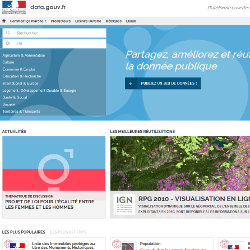
The in-depth revamp of the data.gouv.fr has been given a high level relaunch. The French Prime Minister, Jean-Marc Ayrault and Ministers Marylise Lebranchu and Fleur Pellerin unveiled the portal developed by Etalab.
The government has set three targets for the site, i.e.
- to enable the user to access easily the most pertinent data to respond to the questions he is asking;
- to allow any keeper of public data to share them in no time at all;
- to enhance public data due to the improvements or interpretations of people who re-use them.
Although the interface has been redesigned for better ergonomics compared with the old site which dated from 2011, it’s the content part which is benefiting from this. The portal claims it has 200 contributors of data including research centres, local authorities, representatives of collective organisations and civil society. Etalab has provided a non-comprehensive list of additional data sets, political parties accounts (2011 financial year), grants for parliamentary scrutiny (2012 financial year), number of students or lists of public contracts placed between 2008 and 2012, etc. Some work still remains to be done in some local authorities and territories to make their public data available.
The data are also more numerous – 4 times as many as the previous site, i.e. some 1.45 mn. entries. Etalab explains that this information is destined to be grouped together into series for better legibility. On the old site 350,000 files were grouped into 2,900 series. Today the site comprises 13,000 freely available data sets. The site claims to be “the social network of a community of producers and users of public interest data who are involved in improving and interpreting these data”. The collaborative aspect is therefore highlighted with the involvement of citizens in improving, grading and reusing the data.